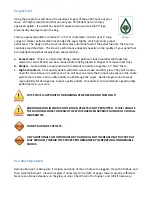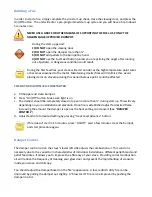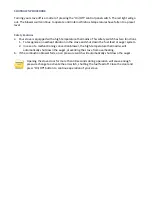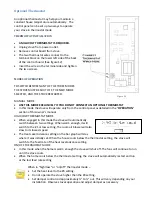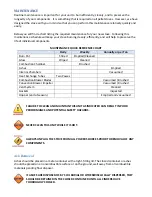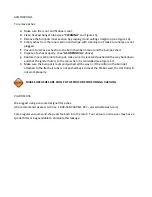
Combustion
Air
Supply
A
2”
inside
diameter
metallic
pipe,
either
flexible
or
rigid,
may
be
attached
to
the
inlet
at
the
stove’s
rear
(refer
to
figure
3).
A
rodent
guard
(minimum
¼”
wire
mesh)/wind
hood
must
be
used
at
the
terminus
(refer
to
figure
4).
All
connections
must
be
secured
and
airtight
by
either
using
the
appropriately
sized
hose
clamp
and/or
UL
‐
181
‐
AP
foil
tape.
For
mobile
home
installations
only
:
2”
inside
diameter
pipe
may
be
used
for
the
first
5
feet
of
combustion
air
supply
run;
from
5
to
10
feet
use
2
¾”
or
larger
inside
diameter
pipe.
Sources
of
Outside
Combustion
Air
1.
In
fireplaces
Chimney
top.
Ash
clean
out
door.
2.
For
freestanding
installations
A
hole
in
floor
near
stove
rear
terminating
only
in
a
ventilated
crawl
space.
A
hole
in
the
wall
behind
the
stove.
If
outside
air
is
not
used,
it
is
important
that
combustion
air
is
easily
available
to
the
air
inlet.
A
closeable
outside
air
register
can
be
used
in
tightly
insulated
homes.
FOR
A
MOBILE
HOME
INSTALLATION
THE
STOVE
MUST
BE
CONNECTED
TO
AN
OUTSIDE
SOURCE
OF
COMBUSTION
AIR.
FOR
MOBILE
HOME
INSTALLATIONS
NO
COMBUSTION
AIR
SUPPLY
MAY
EXCEED
10
FEET.
Electrical
Installation
Voltage
variations
can
lead
to
serious
performance
problems.
The
electrical
system
is
designed
for
120V
AC
with
no
more
than
5%
variation.
Golden
Eagle
Stove
Company
cannot
accept
responsibility
for
poor
performance
or
damage
due
to
inadequate
voltage.
If
connected
to
an
older
two
‐
prong
outlet,
a
separate
ground
wire
should
be
run
to
a
proper
ground
(refer
this
to
a
qualified
technician).
Always
route
the
electrical
cord
so
that
it
will
not
come
into
contact
with
any
hot
part
of
the
stove.
DO
NOT
CONNECT
THE
UNIT
TO
A
GFCI
SOCKET
OR
CIRCUIT.
We
recommend
connecting
to
a
good
quality
surge
protector
that
is
plugged
into
a
standard
three
‐
prong,
120V,
60
Hz
electrical
outlet.
Figure
3
Figure
4
Summary of Contents for Talon
Page 34: ...Electrical Diagram ...


















